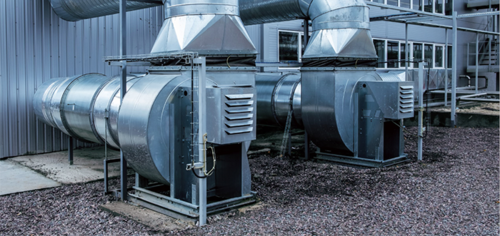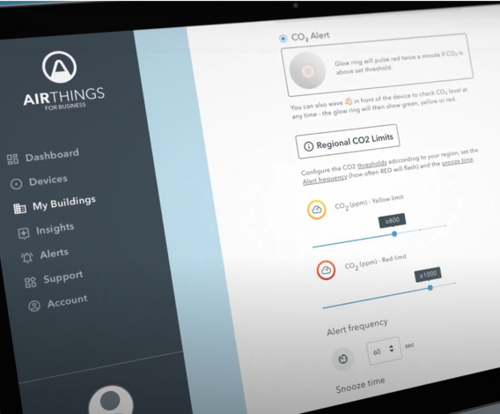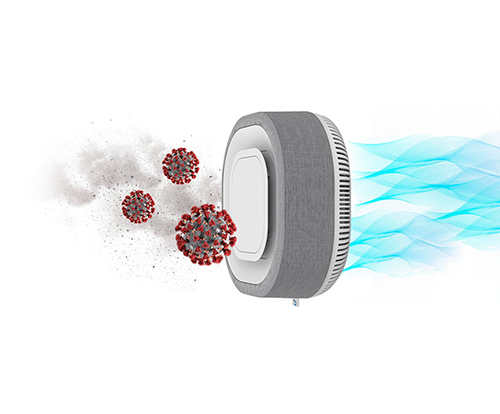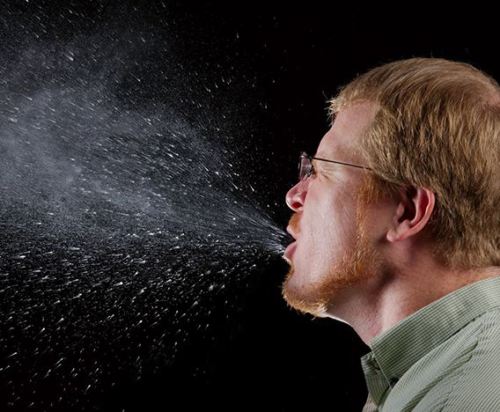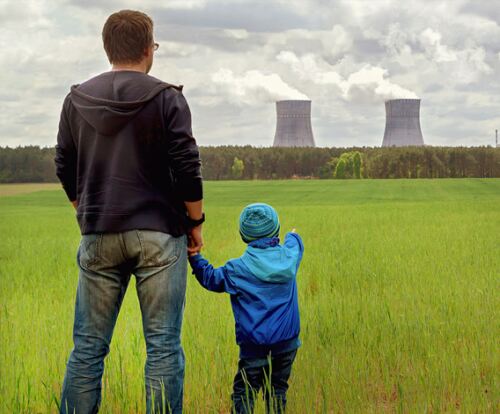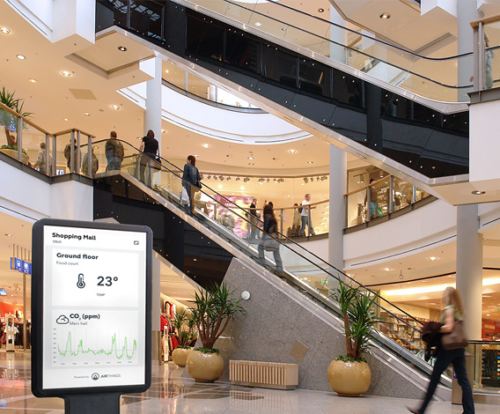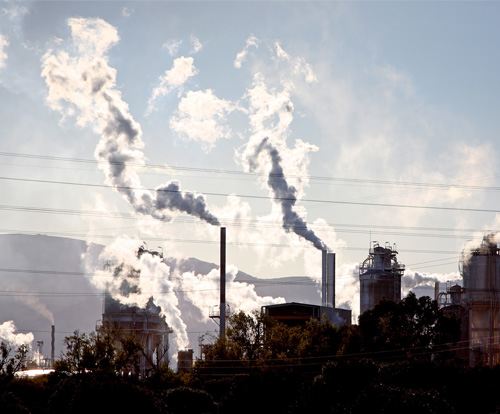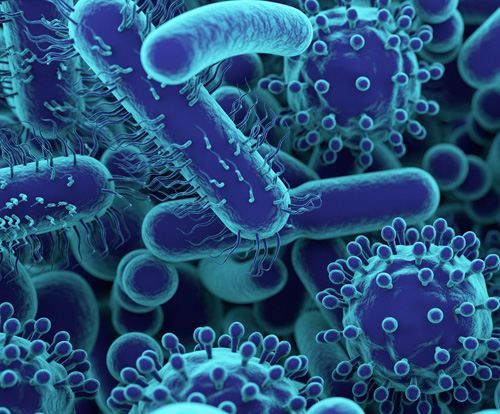
What’s in the air we breathe indoors?
Outdoor air pollution can build up indoors where CO2, VOCs and Radon can also affect the health and wellbeing of building occupants. For more on outdoor pollution click here.
 Carbon dioxide (CO2)
Carbon dioxide (CO2)
 Carbon dioxide (CO2) is a by-product of combustion, as well as a result of the metabolic process in living organisms. Because carbon dioxide is a result of human metabolism, concentrations in a building are often used to indicate whether adequate outdoor air is being supplied to the space. Exposure to carbon dioxide can produce a variety of health effects, including headaches, dizziness, restlessness, a tingling or pins or needles feeling, difficulty breathing, sweating, tiredness, and increased heart rate. High levels are correlated to reduced cognitive function and the increased transmission of airborne viruses like Covid-19, flu and colds.
Carbon dioxide (CO2) is a by-product of combustion, as well as a result of the metabolic process in living organisms. Because carbon dioxide is a result of human metabolism, concentrations in a building are often used to indicate whether adequate outdoor air is being supplied to the space. Exposure to carbon dioxide can produce a variety of health effects, including headaches, dizziness, restlessness, a tingling or pins or needles feeling, difficulty breathing, sweating, tiredness, and increased heart rate. High levels are correlated to reduced cognitive function and the increased transmission of airborne viruses like Covid-19, flu and colds.
Workplaces, schools and colleges frequently have very high levels of CO2 as rooms have high occupancy rates for significant periods of time throughout the day. When a classroom is filled with children CO2 levels rise quickly, often exceeding the DfE guidelines of a maximum 1500ppm (parts per million). And this directly affects the performance and cognitive functioning of room occupants.
 Volatile organic compounds
Volatile organic compounds
(VOCs)
 Volatile organic compounds (VOCs) are a very large group of organic compounds which differ widely in their chemical composition but can display similar behaviour in the atmosphere. VOCs and chemicals from combustion processes such as smoking, heating, cooking or candle burning can produce dangerous chemicals like formaldehyde, which is a known human carcinogen, and is also known to cause irritation to the eyes and upper airways at low concentrations. VOCs are also emitted by many everyday products like cleaning materials, paints, furniture, floor coverings and some toys. New floor coverings and/or furniture should be allowed to off-gas for a day or two in a well ventilated space.
Volatile organic compounds (VOCs) are a very large group of organic compounds which differ widely in their chemical composition but can display similar behaviour in the atmosphere. VOCs and chemicals from combustion processes such as smoking, heating, cooking or candle burning can produce dangerous chemicals like formaldehyde, which is a known human carcinogen, and is also known to cause irritation to the eyes and upper airways at low concentrations. VOCs are also emitted by many everyday products like cleaning materials, paints, furniture, floor coverings and some toys. New floor coverings and/or furniture should be allowed to off-gas for a day or two in a well ventilated space.
 Particulate matter (PM)
Particulate matter (PM)
Particulate matter (PM) is made up of both solid and liquid materials of various sizes of PM1, PM2.5 and PM10, which pollutes the air we breathe. Most particles form in the atmosphere as a result of complex reactions of chemicals such as sulphur dioxide and nitrogen oxides, which are pollutants emitted from power plants, industries and vehicles. Some are emitted directly from a source, such as construction sites, vehicle brake and tyre dust, fires and even salts from the sea.
 Indoor sources of PM include pet dander, bacteria, mould, chemicals from cleaning products, building materials, candles, fuel burning equipment such as wood burning stoves or open fires, cooking and smoking. PM2.5 and PM1 are the most dangerous to human health as they are able to enter deep into the lungs, pass into the blood stream and cause respiratory and cardiovascular morbidity and disease and dementia.
Indoor sources of PM include pet dander, bacteria, mould, chemicals from cleaning products, building materials, candles, fuel burning equipment such as wood burning stoves or open fires, cooking and smoking. PM2.5 and PM1 are the most dangerous to human health as they are able to enter deep into the lungs, pass into the blood stream and cause respiratory and cardiovascular morbidity and disease and dementia.
The World Health Organisation has classified PM as the biggest environmental risk to public health.
 Radon
Radon
Radon is a colourless, odourless radioactive gas formed by the radioactive decay of small amounts of uranium that occur naturally in rocks and soils. It seeps through cracks in floors and walls and underground spaces like cellars and car parks are most susceptible.
 Radon is the number one cause of lung cancer amongst non-smokers, causing around 11,000 deaths in the UK each year. Limited ventilation will trap radon in a room where it can build up to high Levels. The Ionising Radiations Regulations 2019 (IRR19) impose a duty on employers to protect workers, and building managers to protect the public, from exposure to radon.
Radon is the number one cause of lung cancer amongst non-smokers, causing around 11,000 deaths in the UK each year. Limited ventilation will trap radon in a room where it can build up to high Levels. The Ionising Radiations Regulations 2019 (IRR19) impose a duty on employers to protect workers, and building managers to protect the public, from exposure to radon.
Solutions are relatively simple and cost-effective but first you must know if you have a Radon problem, and you can do this by monitoring the air using a radon sensor. Radon test kits can also be purchased from the Government organisation, UK Radon.
 Airborne diseases
Airborne diseases
Airborne diseases pass from one person to another when microorganisms, such as bacteria, fungi, or viruses, travel through the air as aerosols with COVID-19, seasonal flu, the common cold, measles and chickenpox all being transmitted in this way.
 Ways of preventing transmission include the use of personal protective equipment and effective ventilation systems. The pathogens may enter the air in wet droplets, for example, when someone breathes or sneezes. There, they will be suspended in the air, and some droplets dry out, leaving airborne microscopic particles. While suspended in the air, these particles can attach to or enter the body of people nearby. Air currents can disperse the microorganisms, but how far they travel depends partly on the environment. The further the droplets travel from the source, the lower the risk of infection, due to environmental factors.
Ways of preventing transmission include the use of personal protective equipment and effective ventilation systems. The pathogens may enter the air in wet droplets, for example, when someone breathes or sneezes. There, they will be suspended in the air, and some droplets dry out, leaving airborne microscopic particles. While suspended in the air, these particles can attach to or enter the body of people nearby. Air currents can disperse the microorganisms, but how far they travel depends partly on the environment. The further the droplets travel from the source, the lower the risk of infection, due to environmental factors.
Depending on the pathogens, factors that affect how long they remain active include:
- air temperature
- humidity
- exposure to sunlight or other forms of radiation like UV light
- the weight of the particles, which can affect how long they take to settle
- the structure and stability of the pathogen itself
It is not always possible to prevent the spread of airborne diseases, but good ventilation of indoor spaces is advised as the most successful way to keep indoor spaces pathogen free by dispersing stale air with outdoor air.
 Mould spores
Mould spores
 Mould spores are a microscopic fungus, invisible to the naked eye, that thrives in damp, warm conditions that can lead to property damage and serious health issues. Mould needs moisture to grow, so the humidity levels in buildings should be monitored and controlled.
Mould spores are a microscopic fungus, invisible to the naked eye, that thrives in damp, warm conditions that can lead to property damage and serious health issues. Mould needs moisture to grow, so the humidity levels in buildings should be monitored and controlled.
Health issues include aspergillosis, asthma, lung conditions, allergies, runny nose and congestion, eye irritation and sore throat. 4.6 million cases of asthma are attributed to exposure to damp and mould and three people die from asthma attacks in the UK every day.
Latest Articles
The business risks emerging from the global COVID-19 pandemic
Read More >Why indoor spaces have a higher risk of virus transmission
Read More >Enhance HVAC performance, improve energy efficiency and reduce emissions
Read More >High absenteeism and reduced wellbeing
Read More >How does air quality affect your business
Read More >What the experts say
Read More >Risk indicators and monitoring
Read More >Ventilation and filtration
Read More >Transmission & Prevention
Read More >The History of Air Pollution
Read More >Ambient Air Pollution
Read More >Indoor air pollution & the indoor generation
Read More >Climate change and the climate emergency
Read More >What’s in the air we breathe outdoors?
Read More >Other indoor biological pollutants
Read More >How air pollution affects our lives
Read More >

